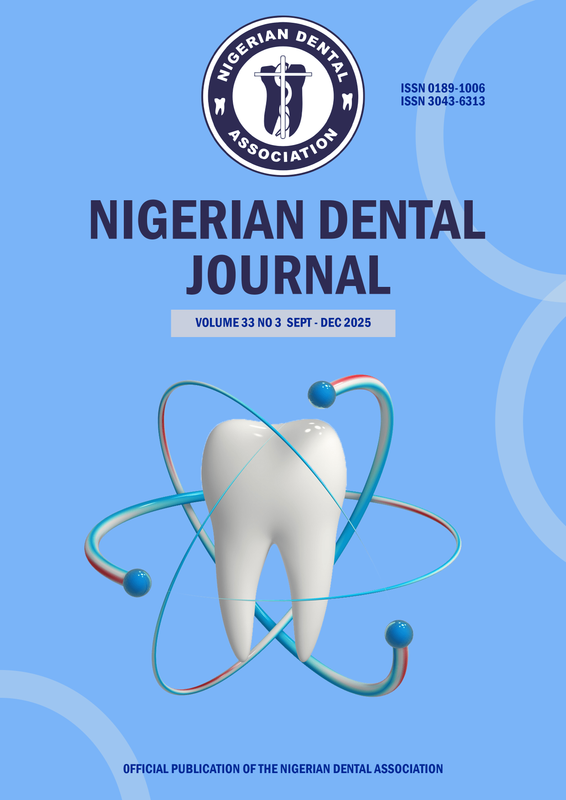Relationship between Quality of Marriages, Marital Counseling and Management of Oral Lesions among Married Female Worshippers attending Religious Worship Centers in South Western Population in Nigeria.
DOI:
https://doi.org/10.61172/ndj.v32i1.268Keywords:
Oral health, Periodontal destructionAbstract
BACKGROUND/ AIMS AND OBJECTIVES
Quality of marriage is a strong indicator of human health. Happily married people tend to show signs of better health when compared to the unmarried. Women in unhappy homes are under chronic stress, they show impaired social behavior, mental stress disorders and cardiovascular diseases. Information on the effects of marriage on oral health is very scanty despite the huge influence of oral health care on the quality of life.
METHODOLODY
This is a longitudinal designed study of female religious worshippers in a south western state of Nigeria. Religious Worship Centres (RWCs) were selected at random in the city. Married females in the selected RWCs were contacted through their leaders on the scheduled date. They were offered health education and were asked to complete a structured questionnaire on their oral health and quality of their marriages. Extra oral and intra oral examination were carried out and the findings recorded. Scaling and polishing, marital counseling with emphasis on the needs to maintain quality marriages, and appropriate routine dental treatments were delivered to all participants. Data analysis was done with STATA 16 software. Relationship between frequency of oral lesions before and after intervention was analyzed for using ttest, p >0.01.
RESULTS
A total of 113 married female religious worshippers participated in the study. Their mean age was 57.9 years SD 12.8. Majority (101, 92%) currently reside with their husbands, 2(2%) divorced and 7% widowed. 81 (71.7%) had good quality of marriages while 32 (28.3%) had poor quality of marriages. Oral lesions seen before intervention are periodontitis (30, 26.5%), xerostomia (25, 22.1%), mouth odour (22, 19.1%) and Orofacial/TMJ pain (27, 23.3%). Lesions are significantly more prevalent among those with poor quality of marriages. After intervention the prevalence of mouth odour, periodontitis, xerostomia and extra marital romantic relationship reduced significantly by 82% (p=0.04), 53% (p=0.001), 76% (p=0.001) and 89 %( p=0.024) respectively.
CONSCLUSION
One third of married, self employed women in their fifth decade of life had poor quality of marriages. Oral lesions are more prevalent among married women with poor quality of marriage and they also have 94.4% chance of getting involved in extra marital romantic relationship. Significant oral lessons were mouth odour, Orofacial pain, xerostomia and periodontitis. Treatment of oral lesions coupled with marital counseling significantly reduced the prevalence of oral lesions and enhanced their marital life.
Key words: Quality
Downloads
References
Snyder-Mackler N, Burger JR, Gaydosh L, Belsky DW, Noppert GA, Campos FA, et al. Social determinants of health and survival in humans and other animals. Science (New York, NY). 2020;368(6493).
Organization WH. Constitution of the world health organization. 1995.
Sartorius N. The meanings of health and its promotion. Croatian medical journal. 2006;47(4):662-4.
Huntington C, Stanley SM, Doss BD, Rhoades GK. Happy, healthy, and wedded? How the transition to marriage affects mental and physical health. Journal of family psychology : JFP : journal of the Division of Family Psychology of the American Psychological Association (Division 43). 2022;36(4):608-17.
Fincham FD, Bradbury TNJJoM, Family t. The assessment of marital quality: A reevaluation. 1987:797-809.
Robles TF. Marital quality and health: Implications for marriage in the 21(st) century. Current directions in psychological science. 2014;23(6):427-32.
Yang X, Jing W, Gao C, Attané I. Smoking behavior of "marriage squeezed" men and its impact on their quality of life: A survey study in China. American journal of men's health. 2019;13(3):1557988319859733.
Pianarosa E, Davison CM. Associations between the self-reported happy home lives and health of Canadian school-aged children: An exploratory analysis with stratification by level of relative family wealth. Journal of mother and child. 2022;25(3):151-69.
de Abreu M, Cruz AJS, Borges-Oliveira AC, Martins RC, Mattos FF. Perspectives on Social and Environmental Determinants of Oral Health. International journal of environmental research and public health. 2021;18(24).
Koenig HG. Religion, spirituality, and health: the research and clinical implications. ISRN psychiatry. 2012;2012:278730.
Lucchetti G, Koenig HG, Lucchetti ALG. Spirituality, religiousness, and mental health: A review of the current scientific evidence. World journal of clinical cases. 2021;9(26):7620-31.
Löe H. The Gingival Index, the Plaque Index and the Retention Index Systems. Journal of periodontology. 1967;38(6):Suppl:610-6.
Omideyi AK. Age at marriage and marital fertility in Eastern Nigeria. Genus. 1983;39(1-4):141-54.
Oziegbe EO, Schepartz LA. Parity, dental caries and implications for maternal depletion syndrome in northern Nigerian Hausa women. PloS one. 2023;18(3):e0281653.
Pittin R. Selective Education: Issues of Gender, Class and Ideology in Northern Nigeria. Review of African Political Economy. 1990(48):7-25.
Inoue Y, Zaitsu T, Oshiro A, Ishimaru M, Taira K, Takahashi H, et al. Association of marital status and access to dental care among the Japanese population: a cross-sectional study. BMC Oral Health. 2022;22(1):278.
Xiu L, Ren Y. Gain or loss? The well-being of women in self-employment. 2022;13.
Tulek A, Mulic A, Runningen M, Lillemo J, Utheim TP, Khan Q, et al. Genetic Aspects of Dental Erosive Wear and Dental Caries. International journal of dentistry. 2021;2021:5566733.
Yaribeygi H, Panahi Y, Sahraei H, Johnston TP, Sahebkar A. The impact of stress on body function: A review. EXCLI journal. 2017;16:1057-72.
Khansari DN, Murgo AJ, Faith RE. Effects of stress on the immune system. Immunology today. 1990;11(5):170-5.
Bulthuis MS, Jan Jager DH, Brand HS. Relationship among perceived stress, xerostomia, and salivary flow rate in patients visiting a saliva clinic. Clin Oral Investig. 2018;22(9):3121-7.
Lavner JA, Clark MA. Workload and Marital Satisfaction over Time: Testing Lagged Spillover and Crossover Effects during the Newlywed Years. Journal of vocational behavior. 2017;101:67-76.
Oyetola E, Ojo M, Mogaji I, Aremu A. Oral ulcerations in Chronic Kidney Disease Patients: Exploring the relationship between clinical presentation of oral ulcers and blood urea concentration. African Journal of Oral and Maxillofacial Pathology and Medicine. 2020;6(1):13-20.
Baniulyte G, Piela K, Culshaw S. How strong is the link between periodontitis and stroke? Evidence-Based Dentistry. 2021;22(1):10-1.
Oyetola E, Afolabi J, Adedeji T. The Influence of Oral Health Care on Prevalence of Urinary Symptoms and mean plasma Prostatic Surface Antigen (PSA) concentration in a Population of Nigerian Adult Males. J Urol Nephrol 2023;10(1):6.
Rizvi DS. Health education and global health: Practices, applications, and future research. Journal of education and health promotion. 2022;11:262.
Mattheus D, Shannon M, Lim E. Benefits of Oral Health Education at Women, Infant, and Children (WIC) Clinic Visits: Assessments of Parent's Oral Health Beliefs, Behaviors and Dental Access in O'ahu, Hawai'i. Hawai'i journal of health & social welfare. 2020;79(5 Suppl 1):32-9.
Schmalz G, Ziebolz D. Special Issue "Oral Health and Systemic Diseases". Journal of clinical medicine. 2020;9(10).
Fazli M, Yazdani R, Mohebbi SZ, Shamshiri AR. Oral health literacy and socio-demographics as determinants of oral health status and preventive behavior measures in participants of a pre-marriage counseling program. PloS one. 2021;16(11):e0258810.
Kardan-Souraki M, Hamzehgardeshi Z, Asadpour I, Mohammadpour RA, Khani S. A Review of Marital Intimacy-Enhancing Interventions among Married Individuals. Global journal of health science. 2016;8(8):53109
Downloads
Published
Issue
Section
License
Copyright (c) 2024 Olufemi Oyetola

This work is licensed under a Creative Commons Attribution 4.0 International License.
Open Access Statement
- We became fully Open Access since January 2023.
- Our new and archived materials are available free of charge on open basis and under a Creative Commons license as stated below.
Copyright statement
Copyright © 1999 The authors. This work, Nigerian Dental Journal by Nigerian Dental Association is licensed under Creative Commons Attribution 4.0 International License.


